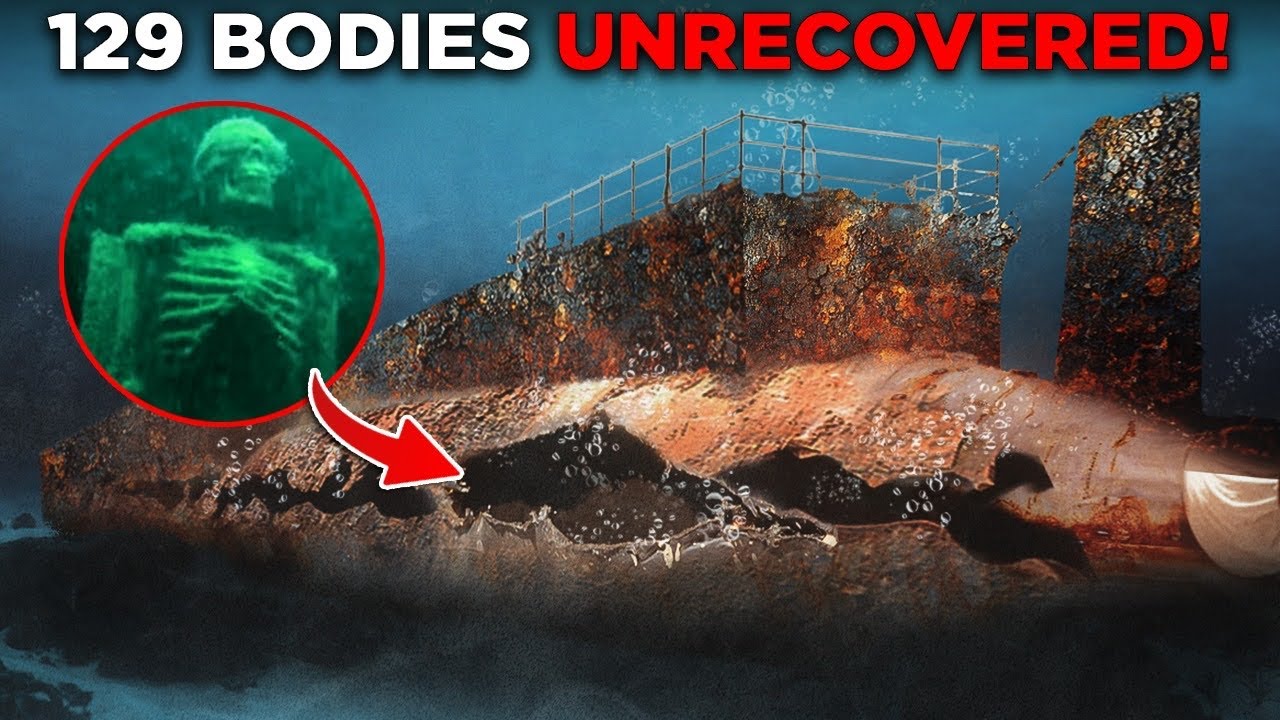Imagine being trapped 8,400 feet beneath the ocean, knowing every second could be your last. 😱
In 1963, the USS Thresher, a cutting-edge nuclear submarine, plunged into the abyss during a routine test dive, carrying 129 souls. Newly uncovered details reveal a chilling sequence of events—desperate messages, failing systems, and a race against time that ended in tragedy. What went wrong in those final, heart-wrenching minutes? The truth will leave you speechless.
Dive into the haunting story and uncover the lessons learned from this naval disaster. Click the link to read more:

On April 9, 1963, the USS Thresher (SSN-593), the United States Navy’s most advanced nuclear-powered attack submarine, set sail from Portsmouth Naval Shipyard in Kittery, Maine, for what was supposed to be a routine deep-diving test. Less than 24 hours later, on April 10, the submarine and its 129 crew members—16 officers, 96 sailors, and 17 civilian technicians—met a catastrophic end 220 miles east of Cape Cod, Massachusetts, in waters 8,400 feet deep. The disaster, the deadliest in U.S. submarine history and the second-worst submarine tragedy globally, marked a pivotal moment for naval safety protocols. Declassified documents and recent analyses have shed new light on the terrifying final minutes of the USS Thresher, revealing a sequence of mechanical failures, human struggles, and haunting questions about what could have been done differently. This article explores the events leading to the disaster, the desperate attempts to avert it, and the lasting legacy of the Thresher’s loss.
The USS Thresher: A Marvel of Cold War Engineering
Commissioned on August 3, 1961, the USS Thresher was the lead ship of its class, designed as a “hunter-killer” submarine to counter Soviet ballistic missile submarines during the Cold War’s peak. Powered by a nuclear reactor, it was the fastest and quietest submarine of its time, capable of diving deeper than its predecessors, with a test depth of approximately 1,300 feet. Its hull, constructed with the new HY-80 steel alloy, was engineered to withstand immense pressure, and its advanced sonar systems made it a stealthy predator in the undersea arms race. The Thresher represented the pinnacle of naval technology, built at a cost of $45 million and launched amid high expectations to secure U.S. dominance in underwater warfare.
Following its commissioning, the Thresher underwent extensive trials in the Atlantic and Caribbean, testing its cutting-edge systems. However, a nine-month overhaul at Portsmouth Naval Shipyard in 1962 revealed numerous deficiencies. A “fast-cruise” simulation in March 1963 exposed critical issues, including a flooding drill that took the crew over 20 minutes to isolate—a delay that would prove fatal at test depth. Despite these red flags, the submarine was deemed sea-ready, and on April 9, 1963, under the command of Lieutenant Commander John Wesley Harvey, the Thresher embarked on its fateful post-overhaul trials, accompanied by the submarine rescue ship USS Skylark (ASR-20).
The Final Dive: A Cascade of Failures
On the morning of April 10, 1963, the Thresher began a series of deep-diving tests to ensure its systems functioned correctly after the overhaul. At approximately 8 a.m., the submarine commenced its descent, maintaining contact with the Skylark via an underwater telephone (UQC). The crew conducted shallow dives initially, reporting no significant issues. By 9:13 a.m., as the Thresher approached its test depth of 1,300 feet, it sent a garbled message to the Skylark: “Experiencing minor difficulties, have positive up-angle, attempting to blow.” This communication suggested the crew was attempting to surface by blowing ballast tanks, a standard emergency procedure to expel water and increase buoyancy.
Moments later, another message, even more distorted, included the phrase “900 north,” interpreted by some as indicating the submarine had descended 900 feet beyond its test depth, reaching approximately 2,200 feet. Sonar technicians on the Skylark reported hearing “air rushing” noises, a chilling indication of potential flooding or system failure. By 9:18 a.m., all communication ceased. Sonar images captured the Thresher breaking apart as it plummeted to the ocean floor, imploding under immense pressure at an estimated depth of 2,400 feet—400 feet beyond its predicted crush depth.
The Navy’s Court of Inquiry, supported by later analyses, pinpointed a likely cause: a failure in a silver-brazed joint in the engine room’s seawater piping system. Unlike welded joints, brazed joints were less robust, and earlier tests had identified potential weaknesses in 14% of the Thresher’s brazed joints, though most were deemed non-critical. A leak in this system likely caused flooding, which short-circuited critical electrical systems, leading to a cascading failure. The electrical bus, which powered the main coolant pumps for the nuclear reactor, shut down at approximately 9:11 a.m., halting propulsion. With the reactor scrammed (shut down), restarting it would have taken nearly 10 minutes—time the crew did not have.
Compounding the crisis, ice buildup in the air lines likely prevented the ballast tanks from blowing effectively, robbing the Thresher of its ability to surface. As the submarine sank deeper, the pressure overwhelmed its hull, leading to a catastrophic implosion. Acoustic data from the Navy’s Sound Surveillance System (SOSUS), analyzed by expert Bruce Rule in 2013, confirmed the implosion occurred at 9:18:24 a.m. at 2,400 feet, killing all aboard instantly.
The Search and Aftermath
The loss of communication triggered an immediate response. The USS Skylark initiated a search, soon joined by submarines like the USS Seawolf and USS Sunbird, along with surface vessels and aircraft. On April 11, the Seawolf reported hearing pings and sonar signals, raising hopes of survivors. Some reports suggested a weak voice was detected via underwater telephone, but experts like naval analyst Norman Polmar dismiss these as ocean noise, asserting the implosion would have been instantaneous. By April 12, the Navy declared the Thresher “overdue and presumed missing,” a devastating blow to the families of the crew, who clung to hope of rescue.
The search continued with advanced technology. The oceanographic vessel USNS Mizar detected metallic objects on the sea floor using sonar on April 15, 1963. By June, the bathyscaphe Trieste II, the only U.S. craft capable of reaching 8,400 feet, located the Thresher’s debris field, scattered across 33 acres. Photographs revealed twisted wreckage, including a pipe marked “593 Boat,” confirming the submarine’s identity. The bodies were never recovered, and the wreckage remains on the ocean floor, monitored periodically for environmental impact from its nuclear reactor, which the Navy assures poses no contamination risk.
A Legacy of Safety Reforms
The Thresher disaster exposed critical flaws in submarine design and construction. The reliance on silver-brazed joints, already problematic in earlier incidents like the USS Barbel’s engine room flooding in 1960, was a significant factor. Additionally, inadequate crew training and rushed production during the Cold War arms race contributed to the tragedy. The crew’s inability to isolate a simulated leak in 20 minutes during the March 1963 fast-cruise highlighted their unpreparedness for emergencies.
In response, the Navy implemented the SUBSAFE program, a rigorous safety initiative mandating improved quality control, watertight integrity, and recovery systems. SUBSAFE has since prevented similar disasters, as evidenced by incidents like the USS San Francisco and USS Connecticut, which survived collisions with undersea mountains. The Deep Submergence Systems Project (DSSP) was also established in 1964 to develop deep-sea rescue capabilities, though the Thresher’s depth made rescue impossible at the time.
Human Toll and Lasting Impact
The human cost of the Thresher’s loss was profound. Families, like that of Chief Petty Officer Robert Eugene Johnson, a torpedoman from Wyandotte, Michigan, were left grappling with grief. Lynne Lawrence, daughter of crewman Richard DesJardins, spoke of the lifelong impact of losing her father, who never saw his children grow up. The tragedy also affected the broader naval community, with figures like the chief engineer at Portsmouth Naval Shipyard reportedly turning to alcohol in the aftermath.
The Thresher’s story, brought to light through declassified documents and efforts by retired Captain James Bryant, who sued for their release in 2019, dispels notions of a cover-up. Instead, it reveals a tragedy born of overconfidence, technical flaws, and the pressures of the Cold War. The disaster remains a somber chapter, but its legacy endures in safer submarines and a Navy committed to learning from its past.
Conclusion
The USS Thresher’s final minutes were a harrowing convergence of mechanical failure and human limitation, unfolding in the crushing depths of the Atlantic. The crew’s desperate struggle, marked by garbled messages and futile attempts to surface, underscores the risks of pushing technological boundaries. While the disaster claimed 129 lives, it spurred reforms that have saved countless others. The Thresher’s wreckage, resting silently 8,400 feet below, serves as a reminder of the sacrifices made in the pursuit of innovation and the enduring need for vigilance in naval operations.





